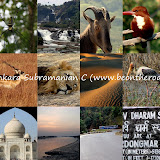The Picturesque Tsomgo (Changu) Lake nestled in the Eastern Himalayas in Sikkim, India
Of days gone by...this April during my solo all India motorcycle journey…
I had reached dry Gangtok after being in rainy Darjeeling for the last 3 days. But, the journey was a rough one, with me having to put up with a busted rear brake. And to add salt to my wounds, the rains caught up with me and it actually turned into a downpour. Finally, it was rest time for my motorcycle as I was in the heavenly north eastern state of Sikkim in India. Since, this small state shares its borders with 3 countries (Nepal, Bhutan and China), one has to get an inner line permit done to visit most of East and North Sikkim. Apart from East and North Sikkim, Indian nationals can easily visit and tour the other parts of Sikkim – Gangtok, South and West Sikkim.

After getting my inner line permits done for visiting East Sikkim, I hopped on a jeep full of tourists that were bound for Tsomgo (Changu) lake. The initial plan was to visit Tsomgo lake and Nathulla pass on the India-China border, but due to rough weather and heavy snowfall, the road from Tsomgo to Nathulla was blocked. The route to the lake i.e. the Gangtok-Nathulla highway (the erstwhile trade route from India to China) wound for about three hours through high mountain passes and next to sharp cliffs on roads built by the Border Roads Organization. There were military establishments on the way and a lot of machines were being employed to clear the mess caused by the landslides. At a lot of places, all the vehicles would have to go at at snail’s pace to avoid the steep drops, the boulders on the road and the slippery slush caused by the rains and the landslides.

Tsomgo (Changu) lake is a small, sacred lake far above the treeline on the Indo-Chinese border and is situated at an altitude of 12,400 feet. Upon arriving at the lake and getting out of the jeep, I was momentarily numbed by the freezing temperatures, but recouped soon to be beset by hordes of locals to take a yak ride on the path covered in snow. Somehow, I managed to evade them and went to a nearby army base situated at a slight elevation to take some pictures. This is where I befriended a couple of soldiers from Tamil Nadu and Karnataka who let me know that I could hike up to the top of the hill to get better views for myself and my lens. I thanked them for the information and off I went on the hike. The hike was a slightly tricky one as the area had received fresh snowfall and my 6 foot 3 inch frame would sink upto my waist at some places. But, I egged myself on and finally after about 50 minutes, I was there at the top. The views of the lake, the Himalayan peaks and the valleys surrounding it were phenomenal. In a short while, I started feeling real cold as most of my clothes had gotten wet in the snow and I retreated my way back down to get some warmth going in my legs. When I reached the tourist section, I could see kids and adults alike were having a great time building snow-men, rolling and smashing snow balls on their friends and taking a yak ride to the moderate-sized temple of lord Shiva that is present on the lake shore.

I had never been on a yak before. So, I decided to take a short ride to the lakeshore and back. The yak is a very strong animal, but I guess it never needs a bath in this weather and hence it emits a strong smell. But, the beauty is they are very sure-footed and are able to handle steep and slippery declines with ease. During my yak-ride, I struck small conversation with the yak-wallah and he told me that the Tsomgo (Changu) lake freezes in winter and makes for a silky white sight!!
The Tsomgo (Changu) lake derives its water from the melting snow on the mountains around. The river Lungtze Chu originates from the Tsomgo (Changu) lake and meets the Rangpo Cgu further down its course. An interesting fact about this lake is that during the older times, lamas used to study the colour of water of the lake and forecast about the future. If the waters had a dark tinge, it foreshadowed a year of trouble and unrest in the state.
All in all, a heavenly experience for me here. And next time, I am bound for his place, I hope the weather gods are kind and let me go up to the Nathulla pass on the India-China border and also pay a visit to the Baba Mandir close by.
To see India through the eyes of a motorcyclist’s lens, visit the album below.
 |
| my solo all-india motorcycle journey |




































